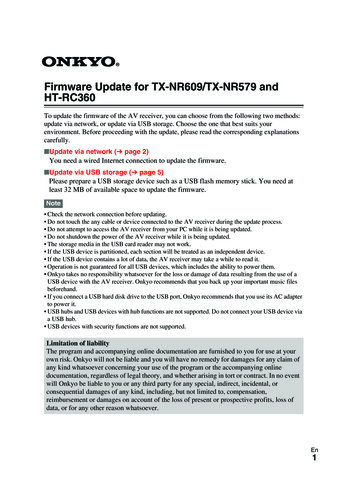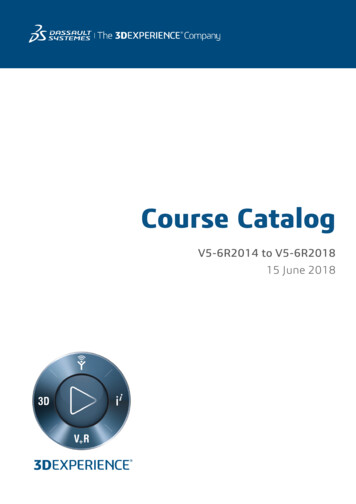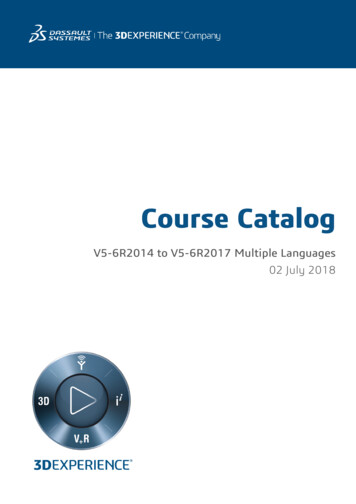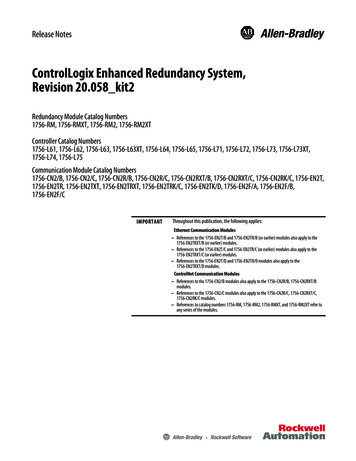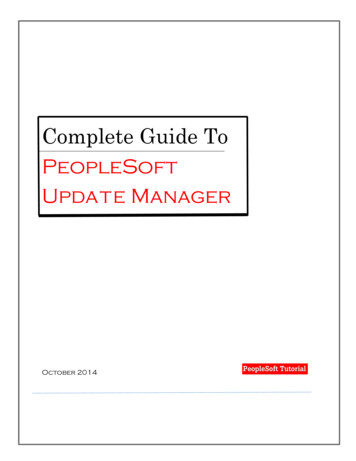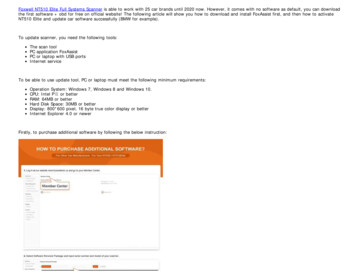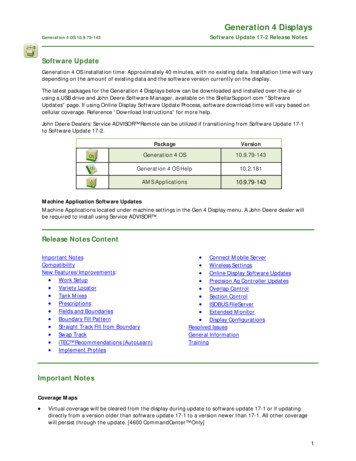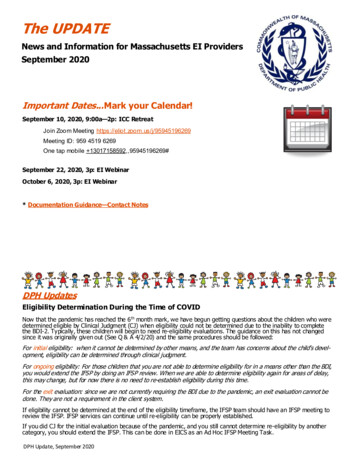
Transcription
The UPDATENews and Information for Massachusetts EI ProvidersSeptember 2020Important Dates.Mark your Calendar!September 10, 2020, 9:00a—2p: ICC RetreatJoin Zoom Meeting https://eliot.zoom.us/j/95945196269Meeting ID: 959 4519 6269One tap mobile 13017158592,,95945196269#September 22, 2020, 3p: EI WebinarOctober 6, 2020, 3p: EI Webinar* Documentation Guidance—Contact NotesDPH UpdatesEligibility Determination During the Time of COVIDNow that the pandemic has reached the 6 th month mark, we have begun getting questions about the children who weredetermined eligible by Clinical Judgment (CJ) when eligibility could not be determined due to the inability to completethe BDI-2. Typically, these children will begin to need re-eligibility evaluations. The guidance on this has not changedsince it was originally given out (See Q & A 4/2/20) and the same procedures should be followed:For initial eligibility: when it cannot be determined by other means, and the team has concerns about the child’s development, eligibility can be determined through clinical judgment.For ongoing eligibility: For those children that you are not able to determine eligibility for in a means other than the BDI,you would extend the IFSP by doing an IFSP review. When we are able to determine eligibility again for areas of delay,this may change, but for now there is no need to re-establish eligibility during this time.For the exit evaluation: since we are not currently requiring the BDI due to the pandemic, an exit evaluation cannot bedone. They are not a requirement in the client system.If eligibility cannot be determined at the end of the eligibility timeframe, the IFSP team should have an IFSP meeting toreview the IFSP. IFSP services can continue until re-eligibility can be properly established.If you did CJ for the initial evaluation because of the pandemic, and you still cannot determine re-eligibility by anothercategory, you should extend the IFSP. This can be done in EICS as an Ad Hoc IFSP Meeting Task.DPH Update, September 2020
Progress Note in EI Client System (CS)Questions from the Field“If we have an IFSP meeting, there is also a note for that and also a weekly progress note for service coordinator.Which one do we fill out?”“When you have extra progress notes that you do not need to use what do you do with them? Can you remove themfrom the dashboard?”Background: P r ogress notes ar e automatically generated by the EI Client System for many activities. Ex amples include initial appointment, BDI, Clinical Judgment, IFSP meetings and for each service that is put on the servicedelivery page of the IFSP. This was done to assure EI Specialists remembered to complete a progress note for each service provided. Staff also have the option to ad hoc to add a progress note in the EI Client System if one is needed andnot available.Guidance: There are times w hen EI Specialists w ill hav e tw o progress notes available. M ultiple activitiescan be billed on the same progress note and all progress notes contain all the available billing codes. Progress noteswere updated in the LIVE System. The choice on each progress note “did not attend” has been updated to “Progressnote not needed” as this seemed to better reflect the clinical practice in the field. All billing activities are required to becaptured in EICS Program starting 12/31/2020 but programs can decide if they want to document multiple billing activities on a single note or which note to choose when two are provided to document the billing activity that occurred.Documentation Guidance—Contact NotesComplete IFSP Reviews Every 6 Months (Minimum)EI Operational Standards state that: “A complete review of the IFSP for a child and the child’s family must be conducted every six (6) months, or more frequently if conditions warrant or if the family requests a meeting to review theIFSP. The purpose of the 6-month review (periodic review) is to determine the degree to which progress is being madetoward achieving the results or outcomes identified in the IFSP, and if modifications or revisions of the results, outcomes, or Early Intervention services identified in the IFSP are necessary. The 6-month review may be carried out by ameeting or by another means that is acceptable to parents and other participants.”How it works in the EI Client System: The EI Client System w ill prompt staff w ith an IFSP meeting task toensure that the IFSP is reviewed at minimum of every 6 months for the duration of a child’s time in EI as per the EIstandards “A complete review of the IFSP for a child and the child’s family must be conducted every six (6) months, ormore frequently.” The EI Client system will automatically generate an IFSP meeting task if 6 months goes by and noIFSP meeting review has been completed. For example, if an initial IFSP is completed and then 3 months later an IFSPmeeting is held to review the IFSP, 6 months after that, the system will generate an IFSP task. The EI Client Systemdoes not automatically create a task that calculates 6 months out from the initial evaluation.Sustainability of Oral Health Equity Project with Early Intervention (EI) ProgramsSince 2016, the Massachusetts Department of Public Health has been implementing the Oral Health Equity Project(OHEP) in the pilot communities of Worcester and Holyoke, where Black and Hispanic youth experience systemic barriers to dental care that result in oral health inequities. Through partnerships with six Early Intervention (EI) Programs,including Criterion Worcester, Pernet, Thom Worcester, South Bay Worcester, Criterion Heritage, and May Center, OHEPhas successfully implemented strategies to increase the number of Black and Hispanic youth who report having a dentalvisit within the last year.Goals of OHEP: Improve knowledge of oral health among EI staff (measured by pre-post training survey conducted at Oral Health101 trainings). Increase the percentage of children reporting a dental appointment in the past year to at least 50% (measured byoral health screening form used at all initial EI intake and 6-month EI follow up appointment).Successes: 104 EI staff members received “Oral Health 101” Training. After the training, 69% of participants were “very comfortable knowing when a child needs to be seen for preventive dental care” compared to 43% prior to the training. 2,974 children were screened over the course of the project. Between November 2019 and January 2020, 50% of children screened were seen for a preventive dental visit bytheir 6-month EI follow up appointment, compared to 27% between May and July 2018.DPH Update, September 20202
Challenges: Need for recurring “Oral Health 101” training to make sure all staff have the knowledge and skills, particularly whenthere is turnover Need for dental screening to be embedded in existing EI forms, instead of as a separate formSustainability and the Future of Oral Health within EI Programs: The “Oral Health 101” training has been turned into an online learning model and can be embedded into EI staff onboarding processes to ensure all new hires have the appropriate oral health knowledge. It is encouraged that EI programs incorporate oral health questions into their family history/intake forms so staff arereminded to start conversations on oral health with each family.Resources:1. Online Oral Health 101 Training - a foundational training on the importance of oral health which can be used whenonboarding new EI staff: (temporary link) https://hsmc.customers.my-lms.net/2. Find a MassHealth Dental Provider: https://provider.masshealth-dental.net/MH Find a Provider#/home3. Massachusetts Oral Health Practice Guidelines for Pregnancy and Early Childhood: al-health-guidelines.pdf4. For Technical Assistance related to Oral Health: ontact-information5. Web link: --July-2019.html?soid 1103447981997&aid JPMMrGLSMiA6. Images below can/should be used in communications materials to encourage and remind clients to schedule oralhealth appointments and practice dental hygiene regularly.Petersen, P. E., & Kwan, S. (2011). Equity, social determinants a nd public hea lth progra mmes –the case of ora l hea lth. Communitydentistry and oral epide miology, 39(6), 481 -487.New podcasts will be featured in this section as they become available.They are always available at https://eionthefly.podbean.com/.This podcast is a collaborative effort of the Massachusetts Department of Public Health and the Virginia Department ofBehavioral Health and Developmental Services (through a contract with the Partnership for People with Disabilities/VCU).”DPH Update, September 20203
Professional Development for EI ProvidersTraining Options for Clinicians Learning the EICSGrab & Go'sGrab-and-Go trainings are for Programs to use with their staff. They are meant to offer Programs a resource to use instaff meeting, supervision, small groups, etc. The training page is designed to present downloadable files for your convenience. To save files, click on the download folder button.Grab & Go: An Introduction to the Early Intervention Client System (EICS) for CliniciansThese resources will support EI Specialists in learning the EI Client System. Includes a scripted PowerPoint presentationthat gives an overview of the EI Client System, identifies and explains key terms and will lead an EI Specialist throughthe steps of completing a case in the EI client system sandbox from referral to discharge. Additional resources to support learning include the activity of EI Client System Sandbox Scenarios for additional self-paced learning and a crosswalk of transition requirements in the EI Operational Standards to the EI Client System.EI Client System (EICS) Sandbox Scenarios - Self-paced Learning ActivityA self-paced learning activity that walks an EI clinician through each step to complete different scenarios of building achild within the EI sandbox.Transition Crosswalk Graphic- EI Operational Standards/ EI Client SystemA crosswalk of transition requirements in the EI Operational Standards to the EI Client System.Virtual TrainingsThe introduction to EICS live training is an alternative way to support EI Specialists in learning the EI Client System. Using the resources included in the Grab & Go: An Introduction to the Early Intervention Client System (EICS) for Clinicians, we will provide a facilitated presentation that gives an overview of the EI Client System, identifies and explainskey terms and will begin to lead an EI Specialist through the steps of completing a case from referral to discharge.There will be no additional information shared than what is offered through the online Grab & Go resources. Instead,this may be a good alternative for learners who require a more facilitated presentation style by a member(s) of the Regional Specialist team.*We will be posting a recorded version, designed to be paused so staff can have time for hands-on practice.Coffee ChatsCoffee Chats are a new way your DPH Regional Specialist team is here to help support the learning of the new EarlyIntervention Client System. After getting to know the EICS through either the Grab & Go training available on Mass.gov,attending one of the Live EICS for Clinicians Introduction, or on your own with the assistance from the sandbox & theuser manual, coffee chats are quick, 60-90 minute time slots designed to dive a little deeper into specific topic areas andanswer any remaining questions you may have. We are hoping this will be a more personalized and interactive trainingexperience. Topics have been chosen through feedback from the field and include: Progress Notes IFSP Transition & DischargePlease continue to let us know if there are any others areas you would like us to nAll of our professional development resources can be found on the Mass.Gov website –Early Intervention Division – atbottom of page, select Professional Development for EI ProvidersTo access additional resources from this page, scroll to bottomOnline Trainings & Resources will bring you to the Training on Demand website (Grab & Go’s and online modules)Virtual Trainings will bring you to the calendar of events (Live & Coffee Chats)DPH Update, September 20204
Specialty Services UpdatesSave the Date!The Autism Insurance Resource Center will be presenting a webinar on Thursday, November 19 from 11am to 12pm.The link will be sent out as the date gets closer. Please mark your calendars!Resources & EventsTelehealth Professional DevelopmentThe Early Intervention/Early Childhood National Community of Practice just released a video reflection activity. This setof universal reflective questions are questions facilitators can use along with the newly released videos around carryingout virtual visits in Early Intervention. You can access the activity here ZYm Aflca9oUT6Q- Ps1B3DYB6km4/edit?ts 5f36a81bThis recent article from DEC breaks down the different components of a telehealth visiting providing a lot of informationto EI Specialists to better engage parents in supporting infants and toddlers through everyday routines and activitiesduring virtual visits. To access the article, click here 3367-e8c0-475f-ba66-bf5580452a07.pdfEnvisioning the Vision Health of US Children All Children’s Health Initiative for Eye andVision Excellence (A.C.H.I.E.V.E.)View the Childhood Vision and Racial Inequity presentation by clicking here.Vision Screening Considerations During the Coronavirus Disease 2019 (COVID-19) Pandemic for Schools, Head Start and Early Care and Education ProgramsThe National Center for Children’s Vision and Eye Health has released this document and an additional list of FAQ’s.This document suggests considerations for modifying vision and eye health screening procedures during the COVID-19pandemic. This document provides a summary of currently available resources that vision screeners and school nursescan consult as they formulate independent judgment. This document is not intended to provide clinical standards orguidelines. Vision screeners and school nurses are responsible for complying with applicable federal, state, and locallaws, regulations, ordinances, executive orders, policies, and any other applicable sources of authority, including anyapplicable standards of practice.Comments, contributions or feedback, please contact:Noah FeldmanNoah.feldman@mass.govDPH Update, September 20205
Sep 09, 2020 · If eligibility cannot be determined at the end of the eligibility timeframe, the IFSP team should have an IFSP meeting to review the IFSP. IFSP services can continue until re-eligibility can be properly established. If you did CJ for the initial evaluation because of the pandemic, and you still ca


